The spring, summer and early autumn months are simply perfect for a road trip around Iceland discovering the breathtaking and mesmerizing landscapes. A magical haven for nature lovers and adventure seekers, the country boasts a multitude (more than 10,000!) of stunning waterfalls.
Whether you’re an intrepid explorer, a solo adventurer seeking solitude, or a family in search of unforgettable experiences, we’ve got you covered with ten of the most majestic cascades in Iceland.
Now, let’s go explore the Foss (that’s Icelandic for waterfall)!
Gullfoss Waterfall
Gullfoss, meaning “Golden Falls,” is one of Iceland’s most iconic waterfalls and not to be missed. Spanning the Hvítá River canyon, it dazzles with a two-tiered cascade dramatically dropping into a steep rugged gorge.
With glacial water thundering down, Gullfoss shows off its sheer power, creating an awe-inspiring spectacle. This famous cascade, easily visited year round while driving the Golden Circle Route, offers a different charm in each season.
- Distance from Reykjavik: Approximately 123 kilometers (76 miles)
- Best Season to Visit: All year round
- Nearby Amenities: Cafeteria and souvenir shop available
- Overnight Visit: Not necessary as Gullfoss can be visited in a day trip from Reykjavik.
Seljalandsfoss Waterfall
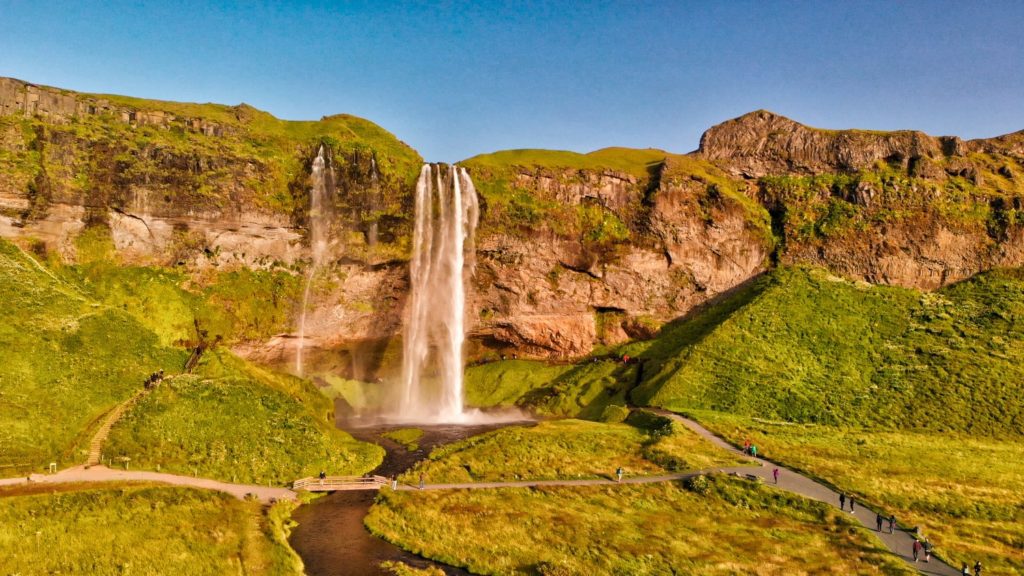
Seljalandsfoss, off the South Coast Ring Road, is one of the most photographed waterfalls in all of Iceland. This cascade, with a 60 meter (200 feet) drop is famous for a unique feature setting it apart from other waterfalls—it allows visitors to venture behind the cascading water curtain. This enchanting experience, especially at sunset, provides a different perspective and fantastic photo opportunities.
- Distance from Reykjavik: Approximately 120 kilometers (75 miles)
- Best Season to Visit: Spring and summer
- Nearby Amenities: Limited amenities available, so it’s advisable to bring food and water.
- Overnight Visit: Not necessary as Seljalandsfoss can be visited in a day trip from Reykjavik.
Skógafoss Waterfall
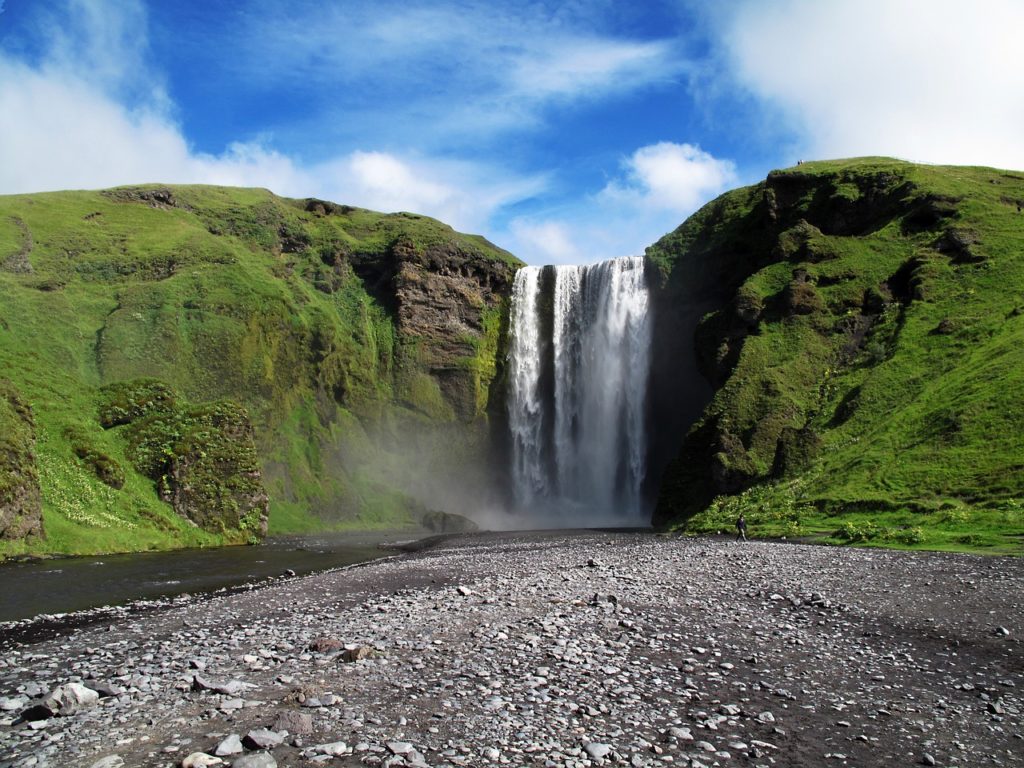
Skógafoss is a majestic waterfall that stands at an impressive height of 60 meters (200 feet) and spans a width of 25 meters (82 feet). One of its distinguishing features is the sheer volume of water that cascades down, creating a beautiful mist that often forms rainbows on sunny days.
While in the area, consider stopping in the nearby village of Skógar and visiting the historical museum to discover how Icelanders lived in the past.
- Distance from Reykjavik: Approximately 150 kilometers (93 miles)
- Best Season to Visit: All year round
- Nearby Amenities: Cafeteria and souvenir shop available
- Overnight Visit: Not necessary as Skógafoss can be visited in a day trip from Reykjavik.
Svartifoss Waterfall
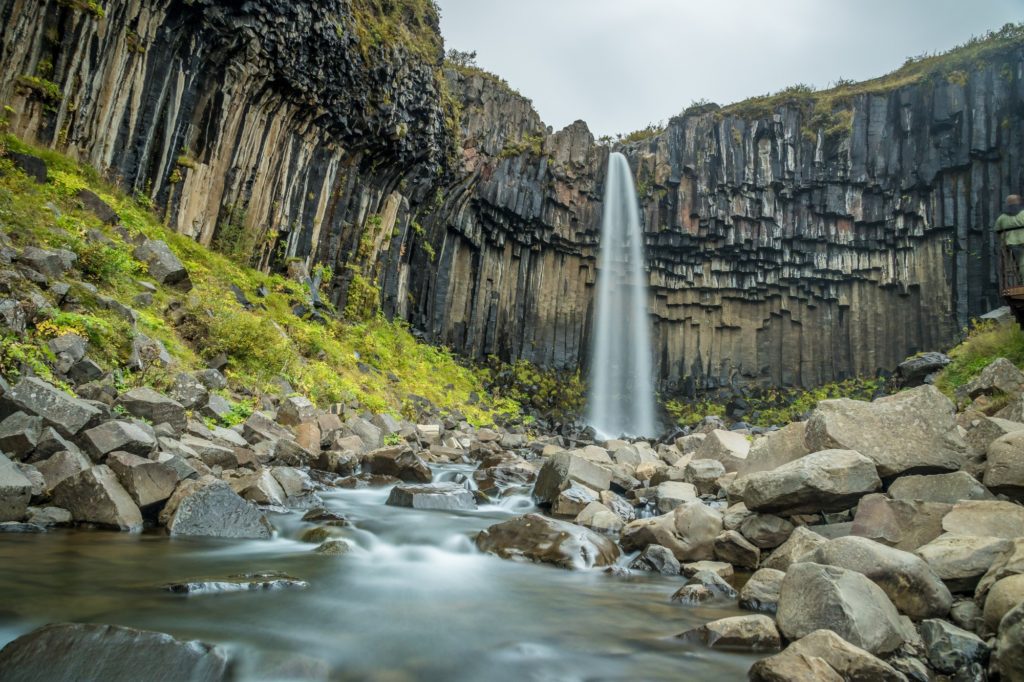
Svartifoss, or “Black Falls,” is renowned for its unique basalt column formations that resemble towering lava organ pipes. Located in Vatnajökull National Park, this waterfall offers a striking contrast between the dark columns and the white cascading water.
If visiting outside of spring, summer, and early autumn do take extreme caution as the trail leading to the waterfall can be icy during winter.
- Distance from Reykjavik: Approximately 327 kilometers (203 miles)
- Best Season to Visit: Spring, summer, and early autumn
- Nearby Amenities: Limited amenities available, so it’s advisable to bring food and water.
- Overnight Visit: An overnight stay is recommended while visiting Svartifoss. There are hostels, hotels and farmstays all along the coastal road from the nearby village of Kalfafellsstadur to Nesjahverfi and beyond in Höfn.
Dettifoss Waterfall
Dettifoss “Raging Falls” is reputed to be Europe’s most powerful waterfall, with a staggering volume of water (1,640 cubic feet of water per second) plunging over a 44 meter (144 feet) drop. Located in Vatnajökull National Park, the raw power and immense scale makes it a captivating sight.
Spring and early summer are the best seasons to visit, as the snowmelt from the highlands increases the flow and intensifies the experience.
- Distance from Reykjavik: Approximately 554 kilometers (344 miles)
- Best Season to Visit: Spring and early summer
- Nearby Amenities: Limited amenities available, so it’s advisable to bring food and water.
- Overnight Visit: An overnight visit is recommended to explore Dettifoss and other nearby attractions. We suggest spending the night in the nearby town of Húsavík or Egilsstaðir.
Goðafoss Waterfall
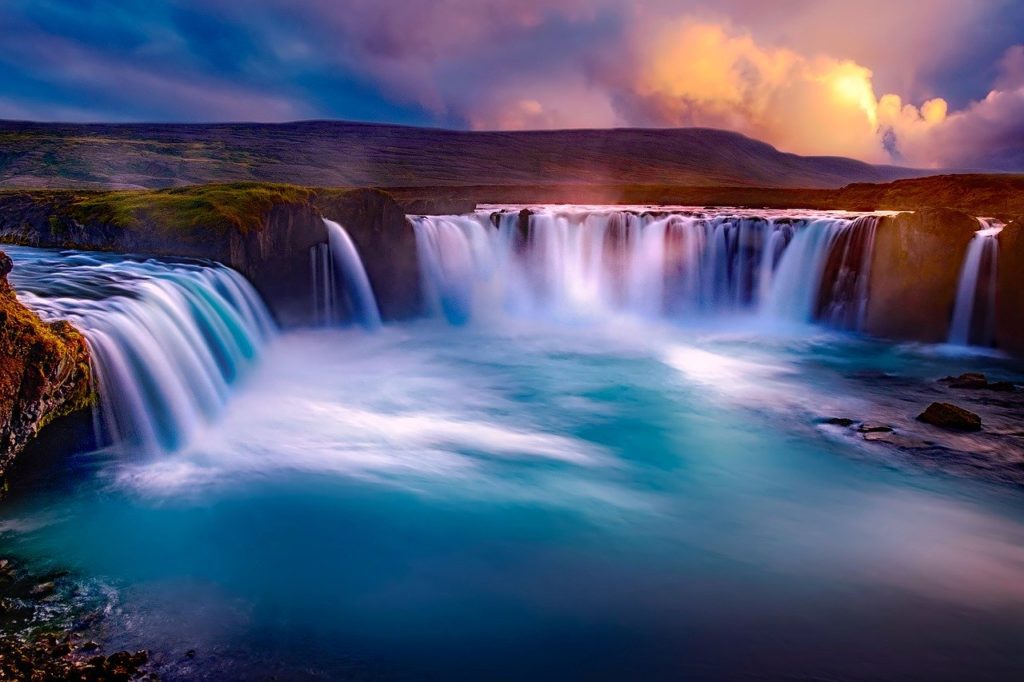
Goðafoss, or the “Waterfall of the Gods,” holds a unique historical and cultural significance in Iceland. According to legend, there was considerable pressure for the early Norse pagans of Iceland to convert to Christianity. In the year 1000, the lawspeaker of the times threw his pagan idols into the falls, symbolizing the country’s conversion to Christianity and averting a war.
Located in the Bárðardalur district on the Diamond Circle Route, Goðafoss boasts a horseshoe-shaped cascade that stretches approximately 30 meters (98 feet) wide. The best season to visit is during spring and summer when the surrounding landscape is lush and vibrant.
- Distance from Reykjavik: Approximately 465 kilometers (289 miles)
- Best Season to Visit: Spring and summer
- Nearby Amenities: Cafeteria and souvenir shop available
- Overnight Visit: An overnight visit is recommended to explore Goðafoss. We suggest spending the night in the nearby coastal town of Húsavík or if you’d like to explore Lake Mývatn, you should stay overnight in Reykjahlíð.
Háifoss Waterfall
Háifoss, or “Tall Falls,” is the third tallest waterfall in Iceland and is renowned for its dramatic drop of 122 meters (400 feet). Located in the Fossárdalur valley of South Iceland, Háifoss offers a mesmerizing vista of cascading water against a backdrop of steep cliffs and a rugged canyon.
From here, it’s also possible to view Iceland’s most explosive volcano, Hekla, known as “The Gateway to Hell”.
The best time to visit the waterfall is during the summer and early autumn months when the roads leading to Háifoss are accessible. Due to the challenging terrain and unpaved roads, inexperienced drivers are recommended to visit with a guided tour.
- Distance from Reykjavik: Approximately 123 kilometers (76 miles)
- Best Season to Visit: Summer and early autumn
- Nearby Amenities: Limited amenities available, so it’s advisable to bring food and water.
- Overnight Visit: Not necessary as Háifoss can be visited in a day trip from Reykjavik, but consider staying in nearby Selfoss or Hella to explore the area further.
Hraunfossar and Barnafoss Waterfalls
Hraunfossar and Barnafoss are a unique duo of waterfalls located in western Iceland.
Hraunfossar, “Lava Falls,” stands out due to its distinctive characteristic of streaming water flowing from the Hallmundarhraun lava fields into the Hvítá River, creating a cascading effect over a distance of nearly 900 meters (2,950 feet).
Barnafoss, adjacent to Hraunfossar, couldn’t be more different, as it features a narrower, darker and more turbulent flow. According to ancient folklore, the powerful, foaming waters claimed the lives of two children and led to the waterfall’s name “Children’s Falls.”
Spring and summer are the best seasons to witness the full glory of these falls.
- Distance from Reykjavik: Approximately 125 kilometers (78 miles)
- Best Season to Visit: Spring and summer for optimal flow
- Nearby Amenities: Cafeteria and souvenir shop available
- Overnight Visit: Not necessary as Hraunfossar and Barnafoss can be visited in a day trip from Reykjavik.
Dynjandi Waterfall
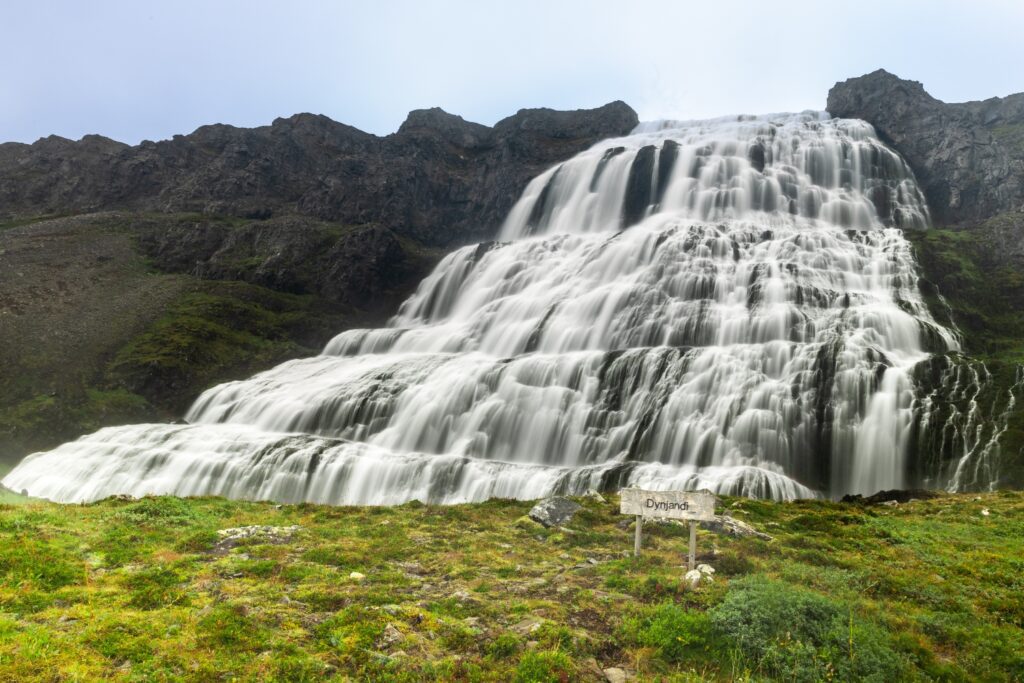
Dynjandi, which means “Thunderous” in Icelandic, is often referred to as the “Jewel of the Westfjords.” This magnificent waterfall cascades down a mountainside in multiple tiers, spanning a total height of 100 meters (330 feet) with the uppermost tier alone standing at an impressive 30 meters (98 feet).
Its elegant and picturesque beauty sets it apart from other waterfalls in Iceland. The largest of its kind in the remote Westfjords region, Dynjandi (Fjallfoss) fans out behind lush greenery and is best visited during the summer months when the roads leading to the area are accessible.
- Distance from Reykjavik: Approximately 385 kilometers (239 miles)
- Best Season to Visit: Summer for accessible roads
- Nearby Amenities: Limited amenities available, so it’s advisable to bring food and water.
- Overnight Visit: An overnight visit is recommended to fully enjoy Dynjandi and the surrounding beauty. Campsites or accommodations in nearby Ísafjörður are available.
Aldeyjarfoss Waterfall
Aldeyjarfoss is a hidden gem nestled amongst the rugged landscape of northern Iceland. Rushing from the Skjálfandafljót river, it plummets 20 meters into a breathtaking blue lagoon.
The distinctive contrast of dark basalt columns against the white cascading water make this waterfall truly unique. Located in the Bárðardalur valley, reaching Aldeyjarfoss requires a drive over rough gravel roads, making it more suitable for experienced drivers with a well-equipped vehicle.
While it is possible to visit Aldeyjarfoss solo, it’s recommended to have experience driving off-road and navigating remote areas. Joining a guided tour is another option for a more convenient and informative visit.
- Distance from Reykjavik: Approximately 385 kilometers (239 miles)
- Best Season to Visit: Summer is the best season to visit Aldeyjarfoss due to better road conditions and accessibility.
- Nearby Amenities: There are limited amenities in the immediate vicinity of Aldeyjarfoss. It is advisable to bring food, water, and other necessities with you.
- Overnight Visit: An overnight visit is recommended to fully appreciate Aldeyjarfoss and explore the surrounding breathtaking landscapes. Consider staying in nearby accommodations or campsites, such as in the town of Húsavík or in the Mývatn area.
For the optimal experience enjoying Iceland’s impressive waterfalls, be sure to wear warm clothing, sturdy waterproof shoes and bring a raincoat. It’s always best to be prepared.
Please explore the rest of our blog for more Icelandic adventure inspiration and all our practical tips for planning your road trip.
Back